Bell Street and the Bethel AME Church
Jacobs Entertainment is requesting street and alley abandonments on the block housing Reno’s most historic African American church.
Hello again and happy weekend! Thanks so much to everyone who has greeted the return of the Brief with such enthusiasm and especially to those who have upgraded to a paid subscription. I appreciate your support more than I can say.
Diving right in, the next Reno City Council meeting is next Wednesday, February 28. You can view the full agenda here, so please skim through for any items of interest.
Item C.1 is an application from Jacobs Entertainment to abandon part of Bell Street and all or part of several contiguous alleys. This Brief takes a closer look at this item, not only because abandonments are serious, as they permanently remove land from the public right-of-way, but because this request could have serious implications for one of Reno’s most significant historical landmarks, the Bethel AME Church.
Let’s get started.
Item C.1: The Bell Street Abandonment
Street abandonment applications are reviewed by multiple City departments, but they only require review by one public body: Reno City Council. This one would also have been discussed for informational purposes at the February 12 Ward 1 NAB meeting, but that unfortunately was cancelled due to lack of quorum, so Wednesday will mark its first public presentation and discussion.
Bell Street is a north-south street running north from Riverside Drive and ending above West Second Street where it connects to an unnamed alley that leads east and west to Ralston and Washington Streets, respectively. It picks up again north of West Fifth Street, but that’s not the section in question.
Jacobs Entertainment is requesting that the City abandon a section of Bell Street in the Powning Addition along with the east-west alley it connects to, as well as part or all of the two north-south alleys on the same block, for a total of approximately 30,600 square feet. You can find a link to the staff report on the agenda as well as photos and maps including the one below, where the sections in question are marked in yellow.
Jacobs has already converted the large parcel (APN #011-640-09) directly north of this site into a paved surface parking lot. You can see what that looks like in a Google Maps image taken in October 2023 and spin around to see the section of Bell Street and the alleys in question.
You may recall this parcel from its appearance in a proposal Jeff Jacobs made in 2022 to donate it and adjacent parcels to the City of Reno if they would pay to develop it into workforce housing along with 3,300 parking spaces (a prospect that the RGJ estimated could cost up to $300 million). Jacobs then announced that the land “will serve as a public surface parking lot for the district—until it is redeveloped.”
Jacobs has also purchased several other parcels to the south of this lot. They bought 250 Bell Street (which includes the site of the Hamilton Homestead) in 2021 for $3.3 million and were issued a demolition permit for it last November. And they also bought the building across from it, 255 Bell Street, in 2021 for $3.1 million. They have applied for a demolition permit for that one, too (both buildings are still standing). They also bought and demolished the Castaway Inn on the block’s southeast corner and a letter from Jacobs dated January 24, 2024 indicated that they are “under contract” to purchase two parcels owned by Charwill LLC (APN #011-021-03 and APN #011-021-04) and have a parking easement on the Washoe County School District property (APN #011-017-12).
If this abandonment request were granted, Jacobs could demolish the two buildings at 250 and 255 Bell Street and extend their existing surface parking lot further south, absorbing the east-west alley, the north end of Bell Street, and parts of the adjoining north-south alleys to create a clean rectangle spanning the width of the entire block.
In fact, we know that that’s just what they intend to do. Although the City’s staff report states that “The abandonment would allow for future consolidation of adjacent parcels intended for code-compliant development of this block,” Jacobs stated in a written response to the City planner’s questions dated January 24 that their intent is “to utilize this block for parking and additional event space for the existing Glow Plaza Festival grounds,” including the map below as illustration.
To view the original application and response letter yourself, visit the Accela site here and under Record Info, select “Attachments” and then download the “Abandonment Submittal” dated 12/27/2023 and the “Combined revision docs” dated 1/25/2024.
You might think that Wednesday’s evaluation of whether or not to grant this abandonment request would require analyzing whether or not the expansion of a surface parking lot, as opposed to, say, a housing project, or a parking garage, or anything else, would be desirable to the City.
You might think that City Council should consider whether Jacobs Entertainment actually needs more surface parking for the Glow Plaza, since they insisted in their permit application for the Glow Plaza that they already had plenty of parking to serve it. You might wonder whether the proposed abandonments make sense in light of the Jacobs’ recent applications to convert the sites of the Desert Rose Inn and Rancho Sierra Motel, both on West 4th Street, into a 207-space surface parking lot and a 230-space surface parking lot, respectively (I just found those this week).
You might think those factors would be relevant to the discussion. But you’d be wrong.
For the purposes of this deliberation, it doesn’t matter what Jacobs wants to do with the land. That letter doesn’t even appear in the City’s posted materials for this item.
Once the land is removed from public ownership, its use reverts to whatever the adjacent zoning allows and any subsequent use that adheres to that zoning could proceed without any additional public review. We saw that play out a few years ago just a few blocks away, where a private landowner took an entire block of Washington Street that had been abandoned by the City specifically to allow private surface parking and decided to build a multi-story building on it instead. Unless specified and restricted (if that’s even possible), the proposed use might not even be the final use.
So if we don’t know the final use, and if the proposed use isn’t relevant anyway, then how is City Council supposed to evaluate this request? Enter Reno City Code.
“Material Injury”
Under the Right-of-Way Abandonment section of the City’s Land Development Code (18.08.707) we find the following line:
In approving any abandonment, the City Council shall find that the public will not be materially injured by the proposed abandonment.
I don’t see a definition of “material injury” in the code, but according to many legal sources, it means harm which is not inconsequential, immaterial, or unimportant.
So that harm would have to be derived not from any future use of the abandoned land, but from the loss of the public rights-of-way themselves. And the members of the “public” whose potential injury should be thoroughly examined are—at least most directly—those who currently use the streets and alleys in question.
Jacobs, for its part, sees no potential material harm. Here’s their response to the question of “material injury”:
Note the sentence: “this section of Bell Street and adjacent alleyways are primarily [emphasis added] used by the subject property owners and petitioners of this abandonment.” Primarily. But not exclusively. Which brings us to Bethel AME.
Reno’s Historic Bethel AME Church
Right in the center of the block, at 220 Bell Street (APN #011-021-05), surrounded on three sides by privately owned parcels, is the Bethel AME Church. I’ll outline the church’s .059-acre parcel in red below.
It would be impossible to overstate the significance of the Bethel AME Church to the history of not just Reno, but the entire state of Nevada. The brief entry on Reno Historical only scratches the surface, so I encourage everyone to read the entire nomination that secured this building a listing in the National Register of Historic Places in 2001. At the time that the nomination was written, the congregation had sold the building to a third party, but they reacquired it in 2003, as explained by Demetrice Dalton on BlackPast.org.
Reno’s Bethel AME Church is the oldest surviving African American church in Nevada. The building was constructed in 1910 for the Reno’s African Methodist Episcopal (AME) congregation, which had been organized in 1907, and was enlarged and remodeled in 1941. Despite the encroachment of modern properties, the building retains a high degree of all seven aspects of evaluated integrity: location, design, setting, materials, workmanship, feeling, and association. It is a survivor.
But it’s not just the building itself that’s important; it’s what has taken place inside. As the National Register nomination states, “Reno’s Bethel AME Church was at the center of the civil rights movement in northern Nevada, but long before the organized civil rights activities of the 1950s and 1960s, Bethel provided a refuge and a foundation for Blacks facing discrimination in the area.”
The building long served as the official meeting location for the local chapter of the NAACP. Through the six decades that Reno reigned as the “Divorce Capital of the World,” Bethel AME—known as “The Biggest Little Church in the West”—offered African American divorce-seekers guidance, food, and a sense of community in the face of rampant racial discrimination, and even operated a boarding house next door. You can read some of that history and view images on RenoDivorceHistory.org.
The congregation currently has many options for this building. Its outstanding historical significance and listing in the National Register make it eligible for substantial funding that is regularly offered by the National Park Service, including Civil Rights Grants and other grant programs to transform it into a cultural center or museum, along with other purposes. In the meantime, the Bethel AME congregation now meets at a larger building in Sparks and another congregation has long been using the original church for its services.
What does this mean for the abandonment application?
You need only look at the configuration of this block to understand the potential material injury to the owners of this central parcel, should the abandonments be granted. The Bethel AME Church has adjacent access to only one public right-of-way: Bell Street. It has no additional property on which to offer any public parking or any outdoor space to hold events or gatherings. The north end of Bell Street and its connected alleyways provide not just 21 non-metered public parking spaces, sidewalks, and multiple avenues of ingress and egress (for emergencies and otherwise), but also substantial public space for potential use during special events.
[2/25/24 addition: I ran out of room in the e-newsletter post so I’m add more images to the web version.] Below are a few City staff photos that indicate which part of Bell Street would be abandoned, should this request be granted. The closure of Bell Street would begin at the north end of the church property and include the rest of the street from that point northward to the Jacobs parcel. You can view more photos including the sections of alleyway to be abandoned here.
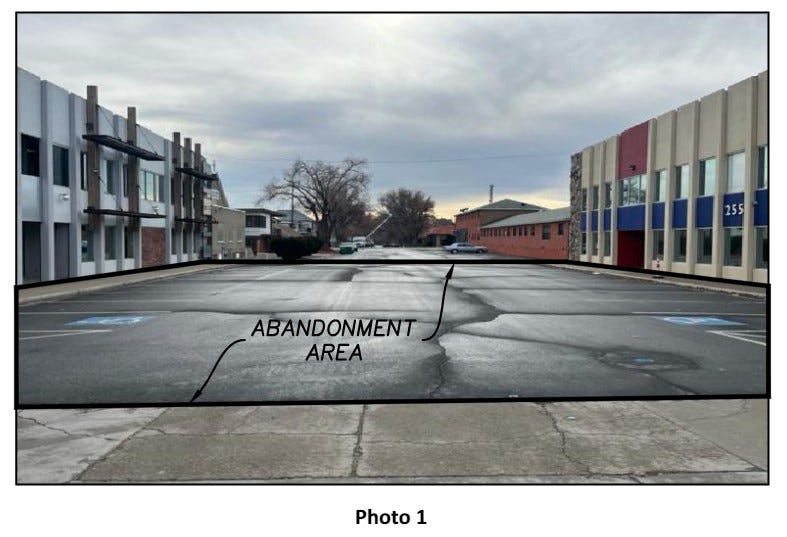


I also want to push back a bit on the contention that we’ve previously seen by Jacobs representative Garrett Gordon that public streets were given to the city “by abutting property owners” when the blocks were originally subdivided, and that street abandonments are merely returning that land to those abutting property owners.
That’s not exactly true. When housing tracts are laid out, streets and alleys are given to the City not by the abutting property owners, but by the developers of those housing tracts, who divide the land they purchased into individual parcels for private sale as well as public streets and alleys for connectivity and access. The owners of individual lots never purchased or owned the City streets that abut their land; they simply enjoyed using the public space adjoining their private property just like everyone else.
The original developer of this block, C.C. Powning, is obviously long dead and gone, but the public streets and alleys he laid out remain today as they were originally intended: for use by the community. And it’s in that spirit of community that we need to consider these important deliberations about potential material injury.
Removing this section of street and these adjacent alleyways from the public right-of-way could seriously handicap this congregation and restrict their usage of this irreplaceable historic building before they have even had a chance to develop a plan for it. If anything, Bethel AME needs more public space and access to surrounding thoroughfares, not less, and they deserve our support and encouragement as they contemplate the future of this irreplaceable historic site. Our governing concern should be to ask how the City can ensure that all options for it remain open, not rush to close them off.
Is it possible that Jacobs Entertainment could offer to allow the Bethel AME Church to use their expanded private surface parking lot, should they secure these abandonments? Sure, it’s possible. But that still wouldn’t offset the loss of public space. And as stated by both City planner Brooklyn Oswald and Jacobs representative Garrett Gordon in 2022 during the abandonment hearing for nearby Church Lane and associated alleys, the consolidation of smaller parcels (both public and private) into larger ones is intended to enable development that puts land back on the tax rolls, generating increased property tax revenue. That isn’t accomplished by turning public streets and alleys into surface parking lots (and it obviously isn’t accomplished by turning the former sites of motels or other structures into surface parking lots, either).
There’s much more to be said about Jacobs Entertainment’s latest actions and promises, including the fact that they promised City Council on November 15 to release their “10-year Master Plan” within 60-90 days (that was 101 days ago), and that they stated that they would not bid on the Bonanza Inn and then swept in to purchase it anyway, undercutting the stated plans by Marmot Properties to purchase and develop it. But that’s a topic for another time. This Brief isn’t about Jacobs Entertainment. It’s about Bethel AME Church, Bell Street, and the public good. Along with the organization Our Story, Inc., I’ve been speaking to a representative of the congregation this week and hope to continue those discussions about the building and this application in the coming days.
If you want to deliver public comment on the Bell Street Abandonment request (item C.1), click on the February 28 City Council meeting agenda and follow the instructions at the top of the page. You can appear in person (the meeting starts at 10 a.m.), or submit comments online at Reno.Gov/PublicComment, via email to Publiccomment@reno.gov, via voice mail at (775) 393-4499 or via Zoom by registering at https://links.reno.gov/Council02-28. On that main agenda you can also scroll down to item C.1 to view the public comments submitted so far.
Be sure to check out my Citizen Guide for helpful resources & links to help anyone become more informed and engaged in issues related to urban development (& more) in Reno.
As always, you can view this and prior newsletters on my Substack site, subscribe to receive each new edition in your email inbox, and follow the Brief (and contribute to the ongoing conversation) on Twitter, Facebook & Instagram. If you feel inspired to contribute to my efforts, sign up for a paid subscription through my Substack site or contribute to my Venmo account at @Dr-Alicia-Barber or via check to Alicia Barber at P.O. Box 11955, Reno, NV 89510. Thanks so much for reading, and have a great week.

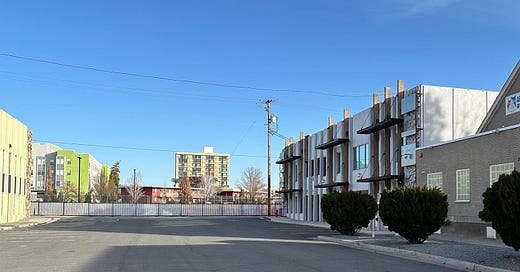



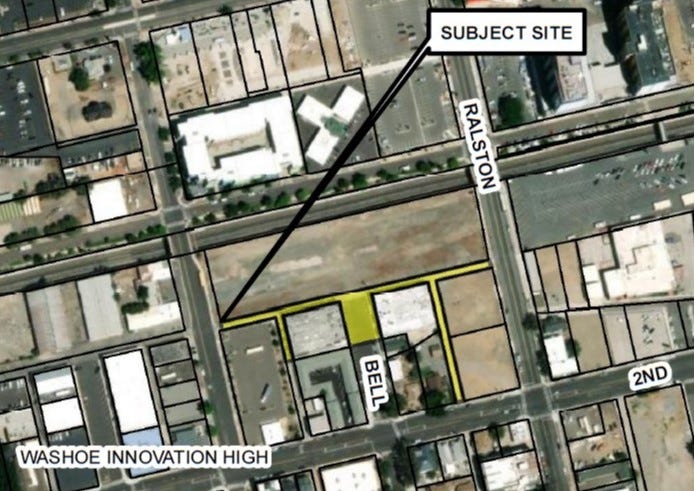
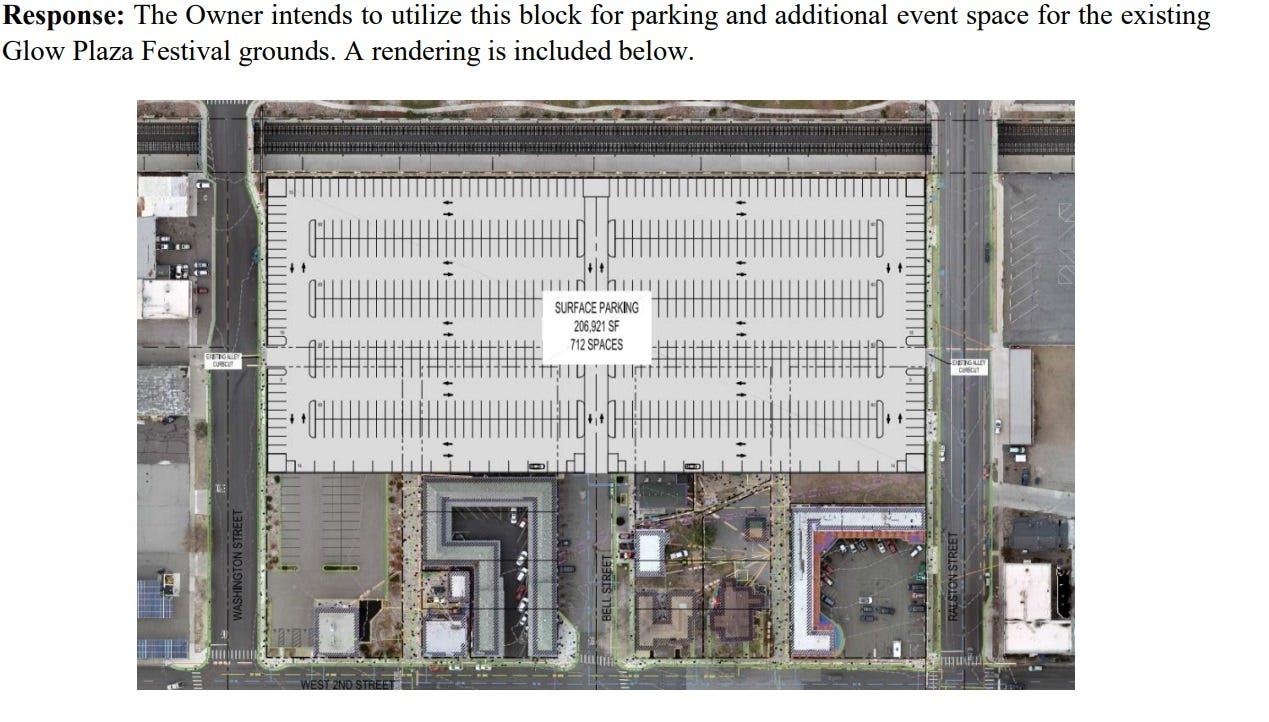

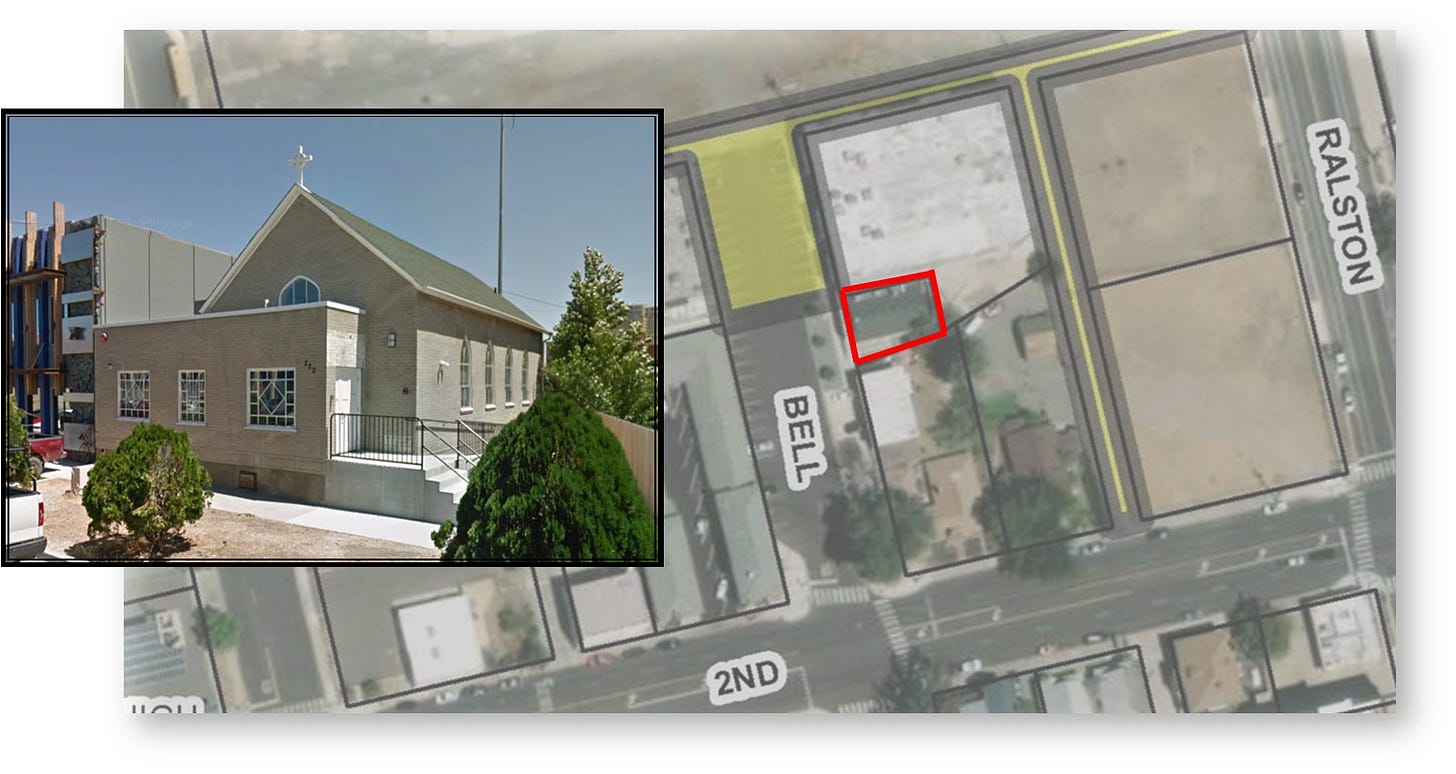
Well, it’s Jacob entertainment
Rubber stamped approved by the city council even before the Wednesday meeting
🤬🤬🤬🤬🤬
Will it never stop? Once again Jacobs Entertainment seeks to erase our history. I wish I could have faith that our city leaders would prioritize the importance of Reno's history and leave it in tact. Reno used to be a destination sought after because of its colorful history. Not any more. So much lost or demolished. Sickening.